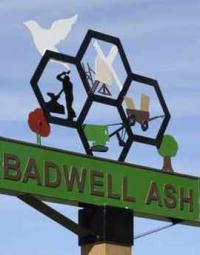



The 36 men on the Roll of Service who survived the war entered many different facets of the armed services, from the army, navy and air force, including:-

Others served only in the UK because they were deemed not fit enough to be sent abroad. Imperfect health prevented the Rev John Henry HEYHAM, for example, from serving abroad. George ROOKARD's bad varicose veins were noted when he had his medical on entry in December 1915, at the age of 24. The army tried operating on the veins, but decided he was not fit to serve abroad. He was posted to a Company of the Anti Aircraft Artillery in Putney and served out the war in the UK. (Rookard is not listed on the roll, but gave his address as 'near the White Horse,' where his wife lived with her father, publican Aaron Durrant, during the war.)
 We know of 4 men who signed up and were deemed ‘not fit' for service and sent home within weeks of their arrival. The health of the rural population of Suffolk then was not as good as it is today. The diet was not the best, there was no NHS and no universal dental care.
We know of 4 men who signed up and were deemed ‘not fit' for service and sent home within weeks of their arrival. The health of the rural population of Suffolk then was not as good as it is today. The diet was not the best, there was no NHS and no universal dental care.Several Badwell men were not allowed to join up because their teeth were bad, a situation occurring widely across the country at the beginning of the war. The numbers rejected were so great that the British Dental Association and similar institutions offered to treat these men for free. By January 1915 men with defective teeth could join up if otherwise fit for general service and willing to undergo dental treatment.
Some military divisions, such as the Cycle Corps, recruited those with bad teeth desperate to join up with the slogan ‘Bad Teeth No Bar.' According to the Roll of Honour Thomas FULLER and George (Raymond) SYMONDS from Badwell took this route into service. Ray Symonds later transferred to the Suffolk Yeomanry.
A blind horse had stood on Eric SYMONDS' leg when he was ten, tearing his muscles. The doctor operated on Eric on the kitchen table, with skin taken off his side to repair the leg. This left him with a huge scar. When he signed up, it was found that his stride was 18 inches with one leg, but only 15 inches with the other. This meant he would be unable to march in time with a unit, so the army discharged him.
At least 9 of the men were awarded the Silver War Badge. The Silver War Badge (first issued in September 1916) was awarded to men who had been honourably discharged due to wounds or sickness. It was worn on civilian clothes to show that the man had fought for his country. It was partly issued to stop the war-wounded being given white feathers, see above.
Harry LARGENT was a driver in the Royal Garrison Artillery. Before the war he had been a general labourer, but came home aged 20 missing an eye and a hand.
Alfred FULLER, aged 29, had been buried alive after an explosion in the trenches and suffered a permanent back injury for the rest of his life.
Albert SMITH, aged 19, suffered a severe injury to his left hand. After his return Albert was offered a job as a postman. Unfortunately he had lost his Discharge Certificate (apparently he asked his mother to burn a box of papers and it was amongst them). Fortunately a replacement was issued!
Arthur GARDINER, whose brother Herbert died in the war, served in the Army Veterinary Corps. He was kicked in the stomach by a mule during the war. The wound became cancerous (previous surgery is a risk factor for stomach cancer.) He was transferred to the military hospital in Bury St Edmunds where he died in 1920, never having recovered.
Whole families of brothers went to war. As you look at the Roll of Service you can imagine the effect on some of these families. 4 SYMONDS and 4 WILDING brothers joined, only two from each family returned. 3 DEWINGs (1 died), 3 LARGENTs (1 died), and several pairs of brothers all left their families and joined up.
Thousands of horses were commandeered in the war. Some for cavalry units, others for transportation. Suffolk Punches were renowned for their strength. Unlike other pulling horses like Shires and Clydesdales, they did not have feathering on their lower legs which meant that they were less prone to illness in the muddy environment of trench warfare.
Margaret SYMONDS was the daughter of Eric (see above) and Badwell's recorder for many years. Her family owned the farm at Shakerland Hall, and she has a story about one of her grandfather's Suffolk Punches. At the start of WW1 the mare was apparently at the Greene King (the local brewery) Yard in Bury St Edmunds, where barley was being unloaded from its dray. An army captain was there commandeering horses. He leant down to feel her forelegs. But he was rough, and the mare kicked out, so he decided not to take her if she was a kicker. And just as well, according to Vic SMITH, who drove the dray, as the horse was so used to delivering to pubs that she stopped automatically at every pub between Badwell and Bury or Badwell and Elmswell.
It is not possible to put all the new research about these men onto this website. For further information about any of these men, or if you have further information, photographs or memorabilia you would like to share, please email us.